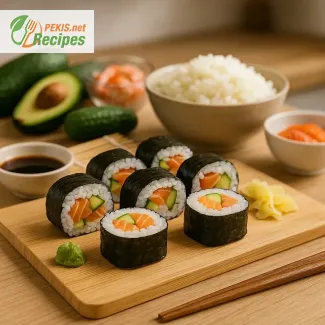
Master the Art of Homemade Sushi with Confidence
A culinary journey into authentic sushi techniques for your home kitchen
Sushi has evolved from a traditional Japanese delicacy into a global culinary sensation. Whether enjoyed at a fine-dining restaurant or as a creative homemade dish, sushi offers a unique fusion of flavor, texture, and presentation that captivates food lovers around the world. Preparing authentic sushi at home may seem like an intimidating process, but with the right tools, techniques, and a clear step-by-step method, it becomes an enjoyable and rewarding experience that anyone can master.
In this comprehensive guide, we focus on how to create restaurant-quality sushi rolls right in your own kitchen. From perfectly seasoned sushi rice to mastering the art of rolling maki, this detailed exploration will equip you with the essential skills and knowledge to prepare homemade sushi that is both delicious and visually stunning. Whether you're a beginner exploring new flavors or a home chef looking to refine your skills, this sushi recipe is tailored to deliver authentic results with accessible ingredients and clear guidance.
Why sushi making at home is worth learning
There is something deeply satisfying about crafting sushi from scratch. Beyond the cost savings compared to dining out, making sushi at home allows you to personalize every bite — from choosing the freshest fish and vegetables to adjusting seasoning and roll sizes. It’s also a wonderful opportunity to connect with Japanese culinary tradition, which emphasizes balance, simplicity, and respect for ingredients.
Home sushi preparation brings versatility. Whether you prefer classic rolls like California or Spicy Tuna, or opt for vegetarian sushi with avocado, cucumber, and pickled radish, the possibilities are endless. Once you learn the fundamentals, you’ll find it easy to experiment with flavors and combinations that suit your taste and dietary needs.
Ingredients that define authentic sushi
One of the most important aspects of sushi is its ingredient quality. While sushi may appear minimalistic, each component plays a critical role in the final result. The foundation of every sushi roll is properly cooked and seasoned sushi rice, made with a precise balance of rice vinegar, sugar, and salt. This rice is what binds the rolls and provides that signature bite and tang.
When it comes to fish, freshness is non-negotiable. Sashimi-grade tuna, salmon, or even cooked shrimp can be used, depending on your preference and availability. Equally important are the vegetable fillings, like crisp cucumber, creamy avocado, or tender pickled daikon, which add color, texture, and freshness to each roll.
Finally, nori sheets (seaweed) wrap everything together, offering a savory note and structure. Served with traditional accompaniments like soy sauce, pickled ginger, and wasabi, sushi becomes a multisensory experience that’s deeply satisfying.
Essential tools for making sushi at home
To prepare authentic sushi at home, you’ll need a few basic tools that make the process smoother:
- Sushi mat (makisu): A bamboo mat used for rolling sushi neatly and evenly.
- Sharp knife: Essential for slicing clean, uniform pieces without crushing the roll.
- Rice paddle or spatula: For mixing and spreading sushi rice without damaging the grains.
- Cutting board and damp cloth: To prevent sticking and keep the work surface clean.
Most of these tools are affordable and widely available, making it easy to assemble your home sushi kit. With the right equipment and preparation, your kitchen can easily transform into your own sushi counter.
The cultural significance of sushi and its variations
Sushi is more than just a dish — it is a symbol of precision, harmony, and respect for ingredients in Japanese culture. Originally developed as a method of preserving fish in fermented rice, sushi has evolved over centuries into an art form that balances visual elegance with gastronomic satisfaction.
Different styles of sushi cater to different experiences. Nigiri, a hand-formed mound of rice topped with sliced fish; maki, the classic rolled sushi with nori on the outside; uramaki, with rice on the outside; and temaki, a hand-rolled cone — each offers a unique way to enjoy the harmony of flavors.
As sushi became popular across the world, chefs began to adapt recipes to local tastes, giving rise to modern favorites like the California Roll, Philadelphia Roll, or Dragon Roll. While these aren't traditional Japanese creations, they reflect sushi’s global reach and its ability to adapt while still respecting its roots.
Making sushi approachable for beginners
One of the most common concerns for beginners is whether they can handle the techniques required to make sushi. The truth is, with a bit of preparation and attention to detail, making sushi at home is surprisingly approachable. The key is to start with simple rolls using cooked or vegetarian ingredients, and gradually progress to more complex recipes as you build confidence.
Following a clear, step-by-step method ensures that you avoid common pitfalls such as overfilling rolls, using improperly seasoned rice, or struggling with sticky fingers and knives. Taking the time to learn foundational techniques not only helps you succeed but also makes the process more enjoyable.
Once you become comfortable with the basics, you can host sushi nights with friends or family, create custom rolls for special occasions, or even turn sushi making into a creative outlet. The satisfaction of presenting beautifully rolled sushi that you made yourself is well worth the effort.
Elevate your cooking skills with sushi preparation
Sushi is an excellent way to sharpen your cooking techniques, from rice preparation and knife skills to plating and presentation. It teaches you patience, mindfulness, and the importance of balance in cooking. It’s also a gateway to exploring other elements of Japanese cuisine, such as miso soup, edamame, or tempura.
By mastering the process of making sushi, you’ll not only impress your guests but also develop a deeper appreciation for Japanese culinary traditions. Every step — from washing the rice to slicing each roll — becomes a ritual that invites focus and intention, transforming cooking into an act of craftsmanship.
What you’ll learn in the following recipe
In the step-by-step sushi recipe that follows, you’ll learn how to:
- Choose the right type of rice and season it perfectly
- Select and prepare fish and vegetable fillings
- Roll different types of maki sushi using a bamboo mat
- Slice rolls cleanly for attractive presentation
- Serve sushi with classic accompaniments for full flavor
This guide is designed to walk you through each phase with clarity and detail, empowering you to create your own delicious, authentic sushi rolls at home. Whether you're preparing dinner for two or hosting a sushi-themed party, this recipe will become a trusted favorite in your kitchen repertoire.
Step 1: Prepare the sushi rice
Rinse the sushi rice thoroughly under cold water until the water runs clear. Combine the rice with water in a saucepan and bring to a boil. Cover, reduce the heat, and simmer for 18–20 minutes. Remove from heat and let rest for 10 minutes covered. In a small pan, heat rice vinegar, sugar, and salt until dissolved (do not boil). Gently fold the mixture into the warm rice using a wooden or silicone spatula. Let the rice cool to room temperature.
Step 2: Prepare the fillings
While the rice is cooling, prepare your fillings. Slice the cucumber, avocado, and carrot into thin strips. Slice the salmon into thin sashimi pieces. Make sure the shrimp are cooked, peeled, and deveined.
Step 3: Set up your rolling station
Place a bamboo sushi mat on a clean surface. Cover the mat with a sheet of plastic wrap to prevent sticking. Lay one sheet of nori (shiny side down) on top of the mat.
Step 4: Assemble the rolls
With damp hands, spread an even layer of rice over two-thirds of the nori sheet, leaving the top edge bare. Lay your chosen fillings (e.g., salmon, avocado, cucumber) horizontally across the center. For cream cheese or shrimp rolls, use similar placement.
Step 5: Roll and seal
Using your fingers, gently press the fillings in place while rolling the mat forward with your thumbs. Apply even pressure to form a tight roll. Moisten the bare edge of the nori with water and press to seal. Repeat with remaining ingredients.
Step 6: Slice and serve
Using a very sharp knife, moistened with water, slice each roll into 6–8 pieces. Wipe the knife clean between each cut to ensure clean slices. Serve with soy sauce, pickled ginger, and wasabi as desired.
Elevate Your Homemade Sushi Experience with Expert Tips
Creative enhancements and smart techniques for better taste, balance, and presentation
Preparing homemade sushi already brings a level of satisfaction and freshness that surpasses many store-bought or even restaurant options. Yet, with a few thoughtful adjustments and deeper understanding of the ingredients and techniques, your sushi can evolve from a great meal into a culinary masterpiece. Whether you're aiming for bolder flavor profiles, cleaner presentation, or more nutritious alternatives, this guide explores practical ways to enhance your traditional sushi recipe while maintaining its authentic character.
Choose the right rice and season it thoughtfully
The quality of your sushi rice directly influences texture, bite, and cohesion. While most recipes suggest using short-grain or medium-grain rice, investing in premium Japanese short-grain rice ensures a more delicate texture and higher starch content, which leads to better stickiness for rolling.
Instead of relying solely on a standard ratio of vinegar, sugar, and salt, consider using kombu (dried kelp) during the rice cooking process to add umami depth. Additionally, substituting white sugar with mirin (sweet rice wine) can create a more rounded sweetness and shine on the rice surface. A light sprinkle of toasted sesame seeds into the finished rice adds subtle nuttiness and visual appeal.
Enhance your fillings with creative textures and flavors
Traditional sushi rolls are often simple, but small changes to fillings can elevate flavor complexity. For example, replacing basic cucumber with pickled cucumber or quick-pickled daikon adds a pleasant tang and crunch. Swapping plain avocado for charred or grilled avocado slices brings a smokier depth that pairs beautifully with raw fish.
For those looking to add a richer taste, try incorporating a thin layer of spicy mayo made from sriracha and Japanese mayonnaise, or a brush of teriyaki glaze on the fish. Adding crispy tempura bits or fried shallots to the filling introduces a crunch that contrasts with the soft rice and creamy textures.
Explore plant-based and health-conscious alternatives
Sushi is easily adapted for vegetarian and vegan diets without sacrificing complexity. Substitute fish with ingredients like roasted sweet potato, grilled tofu, beetroot lox, or marinated mushrooms to mimic the umami richness of traditional proteins.
To make your rolls healthier, use brown sushi rice or a mix of quinoa and white rice to increase fiber content. Replace cream cheese with cashew-based cheese spreads or avocado mousse for creaminess with added nutrients. For the nori-sensitive, thin soy wraps or cucumber ribbons can be used as alternatives.
Adding microgreens, radish sprouts, or shiso leaves enhances both the nutritional profile and visual appeal while introducing earthy or herbaceous notes.
Boost presentation with clean techniques and plating
A frequent obstacle for beginners is overfilling rolls, which leads to poor structure and messy cuts. The secret is to use modest amounts of filling and distribute them evenly. Always keep your knife damp and sharp when slicing to avoid tearing the nori or squishing the roll.
Chill your rolls for a few minutes before cutting to help them set. This ensures clean slices and allows flavors to meld. Use a bamboo mat covered in plastic wrap to avoid sticking and to roll evenly with gentle but firm pressure.
To elevate plating, experiment with minimalist arrangements, adding edible flowers, sesame dust, or finely sliced herbs. Serve with individual portions of dipping sauces to enhance the sensory experience without overwhelming the roll’s balance.
Understand the importance of ingredient temperature and timing
One overlooked factor in sushi preparation is temperature management. Rice should be cooled to room temperature before rolling — too warm, and it softens the nori and damages delicate fillings; too cold, and it becomes dry and stiff. Fish and seafood should also be cold but pliable, ensuring both safety and textural integrity.
Once assembled, sushi should be eaten within 30–60 minutes. After that, rice may harden and seaweed may become soggy. For meal prep, consider assembling ingredients in advance but rolling just before serving.
Avoid common mistakes that compromise taste and texture
A few recurring errors can be easily avoided:
- Using wet or sticky hands leads to rice clumps and uneven rolling. Keep a bowl of water with a splash of rice vinegar to moisten hands and prevent sticking.
- Incorrect rice ratio to nori can result in oversized or loose rolls. A thin, even layer of rice is sufficient for binding.
- Skipping rice seasoning creates bland sushi. The vinegar mix is not optional—it’s essential to sushi’s distinctive flavor.
- Overloading soy sauce masks delicate flavors. Light dipping or brushing ensures balance.
- Using poor-quality fish risks both flavor and safety. Always choose sashimi-grade seafood from reputable suppliers or opt for cooked alternatives.
Tailor the recipe to different taste profiles and occasions
You can easily personalize sushi to match preferences. For children or picky eaters, use cooked proteins like tempura shrimp or teriyaki chicken. For spice lovers, include jalapeños, chili oil, or a dab of wasabi inside the roll. To impress guests, create a platter of varied rolls, combining vibrant vegetables, different fish, and even fruit-infused rolls with mango or strawberries for a surprising twist.
Sushi also works well in bento boxes, picnics, and lunch prep, especially when wrapped tightly and stored in cool environments. If you're making sushi ahead of time, separate wet ingredients like cucumber or sauces to prevent sogginess.
Innovation without losing authenticity
What makes sushi special is its balance of simplicity and refinement. It respects each ingredient’s role and elevates modest elements into something elegant and delicious. While it's tempting to modernize every aspect, the best results often come from small, intentional changes — introducing one new texture, flavor, or ingredient at a time.
By applying these tips, you not only improve the taste and presentation of your sushi but also deepen your understanding and connection to the art of sushi-making. Whether you’re rolling your first maki or perfecting your nigiri, the joy is in the process — and the confidence to make it truly yours.
Allergens present in the recipe:
- Fish (salmon)
- Shellfish (shrimp)
- Soy (soy sauce)
- Dairy (cream cheese, optional)
- Gluten (soy sauce)
Substitution tips to avoid allergens and gluten:
- Replace soy sauce with tamari or coconut aminos for a gluten-free and soy-free option.
- Omit cream cheese or use dairy-free cream cheese to make it lactose-free.
- Avoid fish and shrimp, and use grilled tofu or additional vegetables (e.g., bell pepper, mango) for a vegan version.
Vitamins and minerals per serving (approximate):
- Vitamin A: 2100 IU – supports vision and immune health
- Vitamin C: 12 mg – aids in skin health and collagen production
- Vitamin E: 2 mg – protects cells from oxidative damage
- Vitamin B12: 1.5 µg – supports nervous system and red blood cell formation
- Calcium: 60 mg – essential for bone strength
- Iron: 1.8 mg – important for oxygen transport in blood
- Magnesium: 35 mg – supports muscle and nerve function
- Potassium: 420 mg – helps regulate blood pressure
- Zinc: 1.2 mg – supports immune function
Antioxidants per serving (approximate):
- Beta-carotene: 1200 µg – converts to vitamin A and protects cells
- Lutein + Zeaxanthin: 250 µg – support eye health and prevent macular degeneration
- Selenium: 20 µg – essential antioxidant mineral, supports immunity
- Polyphenols (from soy sauce and vegetables): 90 mg – anti-inflammatory properties and cell protection





